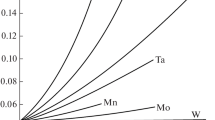Abstract
The addition of nitrogen (0.10 to 0.20 pct) to Fe-Cr-Ni alloys of simulated commercial purity results in a real displacement of the σ phase boundaries to higher chromium contents. The effect is small for the (γ + σ)/γ boundary, but is pronounced for the (γ + α + σ)/(γ + α) boundary. Although there is an indication of an exceptionally large shift of the σ boundaries to higher chromium contents, especially in steels with nitrogen over 0.2 pct, the major portion of this apparent shift results from the fact that carbide and nitride precipitation cause “chromium impoverishment” of the matrices. The effect of combined additions of nitrogen and silicon to the Fe-Cr-Ni phase diagram is demonstrated also. Nitrogen can nullify the effect of about 1 pct Si in shifting the (γ + σ)/γ phase boundary to lower values of chromium at all nickel levels from 8 to 20 pct. Nitrogen can nullify this σ-forming effect of about 2 pct Si at the 8 pct Ni level, but not at the 20 pct Ni level. The alloys studied were in both the cast and the wrought conditions. There are indications that the σ phase forms more slowly in the cast alloys than in the wrought alloys if both are in the completely austenitic state. The presence of δ ferrite in the cast alloys accelerates the formation of σ. Cold working increases the rate of σ formation in both cast and wrought alloys.
Similar content being viewed by others

References
F. B. Foley: The Sigma Phase in Certain High-Chromium Steels. Metallurgia (1946) 34, p. 139.
W. P. Rees, B. D. Burns, and A. J. Cook: Constitution of Iron-Nickel-Chromium Alloys at 650° to 800°C. Journal Iron and Steel Institute (1949) 162, p. 325.
M. E. Nicholson, C. H. Samans, and F. J. Shortsleev: Composition Limits of Sigma Formation in Nickel-Chromium Steels at 1200°F (650°C). Trans. ASM (1952) 44, p. 601.
H. Krainer and M. Leoville-Nowak: The Constitution Diagram of Nitrogen-Containing Chromium-Nickel Steels. Archiv. Eisenhuttenwesen (1942) 15, p. 507.
A. M. Talbot and D. E. Furman: Sigma Formation and its Effect on the Impact Properties of Iron-Nickel-Chromium Alloys. Trans. ASM (1953) 45, p. 429.
G. N. Emmanuel: Sigma Phase and Other Effects of Prolonged Heating at Elevated Temperatures on 25 pct Cr-20 pct Ni Steel. Symposium on Nature, Occurrence, and Effects of Sigma Phase. ASTM Bulletin 110 (1950) pp. 82–99.
W. O. Binder: Some Notes on the Structure and Impact Resistance of Columbium-Bearing 18-8 Steels After Exposure to Elevated Temperatures. Symposium on Nature, Occurrence, and Effects of Sigma Phase. ASTM Bulletin 110 (1950) pp. 146–164.
Author information
Authors and Affiliations
Additional information
Discussion on this paper, TP 3836E, may be sent, 2 copies, to AIME by Jan. 1, 1955. Manuscript, Apr. 15, 1954. Chicago Meeting, November 1954.
Rights and permissions
About this article
Cite this article
Tisinai, G.F., Stanley, J.K. & Samans, C.H. Effect of nitrogen on sigma formation in Cr-Ni steels at 1200°F (650°C). JOM 6, 1259–1267 (1954). https://doi.org/10.1007/BF03398366
Published:
Issue Date:
DOI: https://doi.org/10.1007/BF03398366


